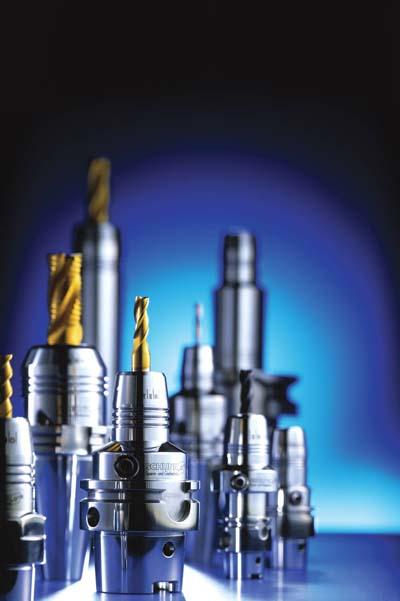
SCHUNK continues to improve its offering of hydraulic toolholders. The company redesigned its TENDO brand toolholders to be able to clamp different types of cutting tools with cylindrical shanks directly in the toolholder without using intermediate sleeves. This makes the toolholder even more universal during its application for various tasks.
Torque transmission capacity has also been increased by up to 15 percent. The already known and proven benefits of TENDO Hydraulic Toolholders remain unchanged. A steel sleeve surrounded by hydraulic fluid performs the clamping of the cutting tool. When initializing the clamping process, an internal piston forces the hydraulic fluid into a cavity surrounding the steel sleeve. The high pressure uniformly forces the sleeve around any cutting tool shank. Cutting tools with different shanks are held with great concentricity of less than 0.003mm run-out.
The enormous clamping pressure displaces oil or grease into the TENDO groove in the clamping bore. Clamping areas remain dry and high torque transmission is guaranteed at all spindle speeds. The hydraulic system also absorbs vibrations inherent in the cutting or grinding processes. The results are very high T.I.R. accuracy and repeatability of less than 3µm (0.00012".) Tool life is extended up to four times and results in greatly improved surface quality of machined parts.
TENDO Hydraulic Toolholders offer precise toolholding solutions for almost every manufacturing process. The toolholders are suitable for high-speed machining and fine milling, heavy-duty milling, wood machining, internal grinding, boring and chamfering, precision reaming, and precision tool grinding. With TENDO intermediate sleeves, different shank diameters can be clamped in the same toolholder for additional application versatility and tooling cost savings.
All TENDO Hydraulic Toolholders are completely closed systems that operate free of dirt, coolants, lubricants, and chips to ensure low maintenance and high operating lifetime. As an option, TENDO Hydraulic Toolholders are available with a radial length adjustment allowing micro-precise tool length adjustment to guarantee higher process performance.
Contact Details
Related Glossary Terms
- boring
boring
Enlarging a hole that already has been drilled or cored. Generally, it is an operation of truing the previously drilled hole with a single-point, lathe-type tool. Boring is essentially internal turning, in that usually a single-point cutting tool forms the internal shape. Some tools are available with two cutting edges to balance cutting forces.
- chamfering
chamfering
Machining a bevel on a workpiece or tool; improves a tool’s entrance into the cut.
- gang cutting ( milling)
gang cutting ( milling)
Machining with several cutters mounted on a single arbor, generally for simultaneous cutting.
- grinding
grinding
Machining operation in which material is removed from the workpiece by a powered abrasive wheel, stone, belt, paste, sheet, compound, slurry, etc. Takes various forms: surface grinding (creates flat and/or squared surfaces); cylindrical grinding (for external cylindrical and tapered shapes, fillets, undercuts, etc.); centerless grinding; chamfering; thread and form grinding; tool and cutter grinding; offhand grinding; lapping and polishing (grinding with extremely fine grits to create ultrasmooth surfaces); honing; and disc grinding.
- milling
milling
Machining operation in which metal or other material is removed by applying power to a rotating cutter. In vertical milling, the cutting tool is mounted vertically on the spindle. In horizontal milling, the cutting tool is mounted horizontally, either directly on the spindle or on an arbor. Horizontal milling is further broken down into conventional milling, where the cutter rotates opposite the direction of feed, or “up” into the workpiece; and climb milling, where the cutter rotates in the direction of feed, or “down” into the workpiece. Milling operations include plane or surface milling, endmilling, facemilling, angle milling, form milling and profiling.
- shank
shank
Main body of a tool; the portion of a drill or similar end-held tool that fits into a collet, chuck or similar mounting device.
- toolholder
toolholder
Secures a cutting tool during a machining operation. Basic types include block, cartridge, chuck, collet, fixed, modular, quick-change and rotating.

